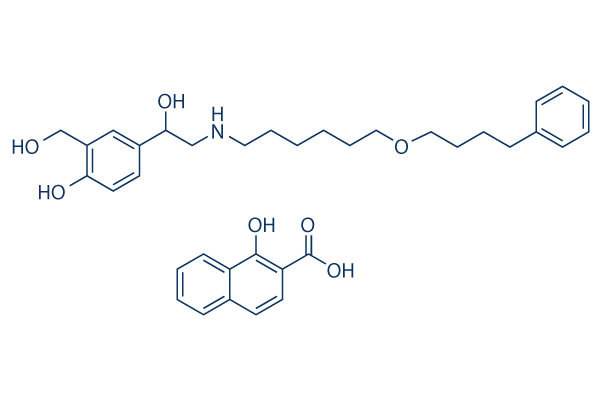| Description: |
Salmeterol xinafoate is a long-acting beta-2 adrenergic receptor (β2AR) agonist, with Ki of 1.5 nM for WT β2AR, and used for asthma treatment. |
| Target: |
Ki: 1.5 nM (WT β2AR)[2] |
| In Vivo: |
The OVA/LPS groups with salmeterol result in a significant decrease in the enhanced AHR in allergic mice in a dose-dependent manner. Salmeterol contends with asthma via regulating the inflammation of the airway of the mice[4]. |
| In Vitro: |
Salmeterol significantly inhibits production of pro-inflammatory mediators by RAW264.7 and THP-1 cells. Salmeterol downregulates PgLPS-mediated phosphorylation of the ERK1/2 and JNK but not p38 MAP kinases (MAP-K). Salmeterol also attenuates the activation of NF-κB via inhibition of nuclear translocation of p65-NFκB, the transcriptional activity of NF-κB and IκBα phosphorylation[1]. Salmeterol shows very high selectivity for the WT β2AR (β1 Ki /β2 Ki ratio of approximately 1500) with Ki of 1.5±0.4 nM[2]. Salmeterol prevents phosphorylation levels of IRS-1Ser307 induced by tumor necrosis factor-α. Salmeterol alone prevents cell death in retinal Müller cells (p<0.05 versus 25 mM glucose). Salmeterol in conbination with IRS-1 shRNA shows a significant increase in cell death compared to salmeterol alone. Moreover, salmeterol alone treatment significantly reduces cytochrome C levels, with the effect lessened when salmeterol is combined with IRS-1 shRNA[3]. Salmeterol (100 μM) causes apoptosis of DCs, and can not affect the differentiation and maturation of DCs at 10 μM. Salmeterol (10 μM) decreases the mRNA and protein levels of pro-inflammatory cytokines in LPS-activated DCs and inhibits MAPK and NF-κB activation[4]. |
| Kinase Assay: |
The cells are rinsed twice with ice-cold phosphate-buffered saline and mechanically detached in ice-cold buffer containing 10 mM Tris·HCl, pH 7.4, 5 mM EDTA, 10 μg/mL benzamidine, 10 μg/mL soybean trypsin inhibitor (type II-S), and 5 μg/mL leupeptin (lysis buffer). The lysate is centrifuged at 45,000 ×g for 10 min at 4°C. The pellet is rehomogenized in lysis buffer, with a Potter-type homogenizer, and stored at −80°C until use. The competition binding assays are performed in buffer containing 75 mM Tris·HCl, pH 7.4, 12.5 mM MgCl2, and 2 mM EDTA, using 1-5 μg of membrane protein, 50 pM 125I-CYP, and 0-100 μM unlabeled ligand in the presence of 100 μM GTP, for 60 min at 37°C. The binding reaction is terminated by dilution and rapid filtration through Whatman GF/C filters; the filters are washed three times with solution containing 25 mM Tris·HCl, pH 7.4, and 1 mM MgCl2. Nonspecific binding is determined in the presence of 5 μM (±)-propranolol. The radioactivity on the filters is counted with a γ-counter. |
| Animal Administration: |
All mice are sensitized on days 0 and 14 by intraperitoneal injection of either PBS or 0.08 mg OVA and 0.1 mL aluminum hydroxide in 0.1 mL of PBS (pH 7.4). After sensitization, animals are exposed to aerosolized PBS-only (negative control), 1% OVS/PBS (acute exposure), 1% OVA/0.01% LPS/PBS (extra LPS exposure) or 1% OVA/0.01% LPS/salmeterol/PBS (sal treatment) for 40 min, once per day for 3 consecutive days (days 24-26). On day 27, the mice are killed and lungs are divided into two groups for analysis: the left lung lobes are lavaged three times with 1 mL of PBS with 1% fetal calf serum and 5 U/mL heparin, and the right halves are fixed by 4% paraformaldehyde for histological analysis. |
| References: |
[1]. Sharma M, et al. Salmeterol; A Long Acting β2-Aderenergic Receptor Agonist Inhibits Macrophage Activation by Lipopolysaccharide From Porphyromonas Gingivalis. J Periodontol. 2017 Mar 3:1-17.
[2]. Isogaya M, et al. Identification of a key amino acid of the beta2-adrenergic receptor for high affinity binding of salmeterol. Mol Pharmacol. 1998 Oct;54(4):616-22.
[3]. Walker RJ, Anderson NM, Bahouth S, Silencing of insulin receptor substrate-1 increases cell death in retinal Müller cells. Mol Vis. 2012;18:271-9. Epub 2012 Feb 1.
[4]. Hu Z, et al. Salmeterol attenuates the inflammatory response in asthma and decreases the pro-inflammatory cytokine secretion of dendritic cells. Cell Mol Immunol. 2012 May;9(3):267-75. |






















